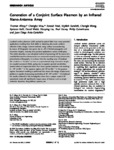Generation of a Conjoint Surface Plasmon by an Infrared Nano‐Antenna Array
| dc.contributor.author | Allsop, T | |
| dc.contributor.author | Mou, C | |
| dc.contributor.author | Neal, R | |
| dc.contributor.author | Kundrát, V | |
| dc.contributor.author | Wang, C | |
| dc.contributor.author | Kalli, K | |
| dc.contributor.author | Webb, D | |
| dc.contributor.author | Liu, X | |
| dc.contributor.author | Davey, Paul | |
| dc.contributor.author | Culverhouse, P | |
| dc.contributor.author | Diego Ania-Castañón, J | |
| dc.date.accessioned | 2022-02-25T14:07:36Z | |
| dc.date.available | 2022-02-25T14:07:36Z | |
| dc.date.issued | 2021-02 | |
| dc.identifier.issn | 2699-9293 | |
| dc.identifier.issn | 2699-9293 | |
| dc.identifier.other | 2000003 | |
| dc.identifier.uri | http://hdl.handle.net/10026.1/18858 | |
| dc.description.abstract |
Localized surface plasmons (LSP) excited by optical fields have many potential applications resulting from their ability in detecting ultra-small, ambient refractive index change. Current methods using surface nano-patterning by means of lithography have given rise to LSP of limited propagation and interaction lengths, meaning that practical applications remain challenging. This article describes a new all-optical method of generating LSP by means of a carefully fabricated low-dimensional nano-structured material using a direct-write photochemical lithography. It is shown that the resulting array of localized SPs combine or “Conjoin” to have an unprecedented large interaction length, via coupled evanescent fields, giving rise to superior spectral sensitivities; several orders of magnitude better than those quoted elsewhere and reaching 6 103 nm RIU1 in the aqueous regime and 104 nm RIU1 in the gaseous regime. Numerical modeling is performed that shows this design of plasmonic platform is capable of producing sensitivities of 105 –106 nm RIU1 . It is believed the results achieved in this investigation show that a unique conjoint SP operational mode will significantly impact areas of interest, such as single molecular dynamics, drug delivery systems, etc. | |
| dc.format.extent | 2000003- | |
| dc.language | en | |
| dc.language.iso | en | |
| dc.publisher | Wiley Open Access | |
| dc.subject | Biotechnology | |
| dc.title | Generation of a Conjoint Surface Plasmon by an Infrared Nano‐Antenna Array | |
| dc.type | journal-article | |
| plymouth.issue | 2 | |
| plymouth.volume | 2 | |
| plymouth.publication-status | Published | |
| plymouth.journal | Advanced Photonics Research | |
| dc.identifier.doi | 10.1002/adpr.202000003 | |
| plymouth.organisational-group | /Plymouth | |
| plymouth.organisational-group | /Plymouth/Faculty of Science and Engineering | |
| plymouth.organisational-group | /Plymouth/Faculty of Science and Engineering/School of Engineering, Computing and Mathematics | |
| plymouth.organisational-group | /Plymouth/REF 2021 Researchers by UoA | |
| plymouth.organisational-group | /Plymouth/REF 2021 Researchers by UoA/UoA12 Engineering | |
| plymouth.organisational-group | /Plymouth/Users by role | |
| plymouth.organisational-group | /Plymouth/Users by role/Academics | |
| dcterms.dateAccepted | 2020-10-27 | |
| dc.rights.embargodate | 2022-2-26 | |
| dc.identifier.eissn | 2699-9293 | |
| dc.rights.embargoperiod | Not known | |
| rioxxterms.funder | EPSRC | |
| rioxxterms.identifier.project | Grating and waveguide plasmonic sensors | |
| rioxxterms.versionofrecord | 10.1002/adpr.202000003 | |
| rioxxterms.licenseref.uri | http://www.rioxx.net/licenses/all-rights-reserved | |
| rioxxterms.licenseref.startdate | 2021-02 | |
| rioxxterms.type | Journal Article/Review | |
| plymouth.funder | Grating and waveguide plasmonic sensors::EPSRC |


